Joe Blevins's Blog, page 14
December 6, 2024
2024 Comics Fun Advent Calendar, Day 6: Alice in Somethingland
 They totally ripped off that Tom Petty video.
They totally ripped off that Tom Petty video.Have you ever heard a good answer to the Mad Hatter's famous riddle about why a raven is like a writing desk? Of the explanations I've heard, the one I like best is that Poe wrote on both of them. (He wrote about a raven while literally writing on a desk. Get it?) But even that didn't satisfy me, so I scripted the vignette you see above. Actually, this little comic was my way of reusing some famous artwork by Sir John Tenniel (1820-1914). In particular, I like the expression he gave Alice here. You can tell she's just about had it with the Hatter.
var infolinks_pid = 3415273; var infolinks_wsid = 0;
Published on December 06, 2024 03:00
December 5, 2024
2024 Comics Fun Advent Calendar, Day 5: The Silver Surfer crossover you didn't know you needed!
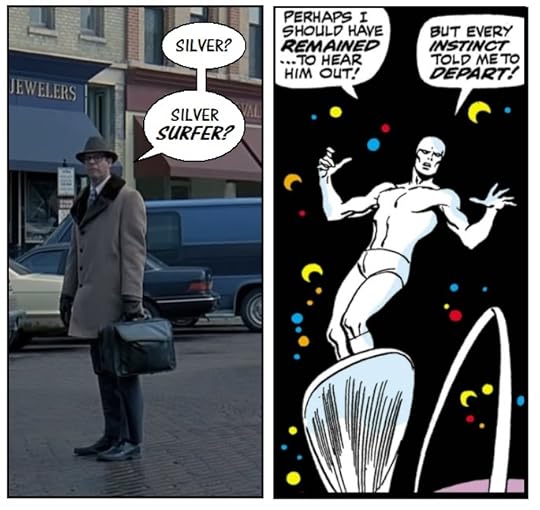 Filmed not too far from where I live!
Filmed not too far from where I live!There used to be a great Twitter account called Comics Out of Context that would regularly post random panels from old comic books, mainly DC and Marvel. I'd often use these tweets as the basis for comics of my own. That account is long gone, but I held on to some of the parodies I did, like the one you see above. I think a lot of the comics I'm going to post this month with come from that same stash.
By the way, if you happen to run into the person who ran the Comics Out of Context account, tell him (or her) to drop me a line.
var infolinks_pid = 3415273; var infolinks_wsid = 0;
Published on December 05, 2024 03:00
Comics Fun Advent Calendar, Day 5: The Silver Surfer crossover you didn't know you needed!
 Filmed not too far from where I live!
Filmed not too far from where I live!There used to be a great Twitter account called Comics Out of Context that would regularly post random panels from old comic books, mainly DC and Marvel. I'd often use these tweets as the basis for comics of my own. That account is long gone, but I held on to some of the parodies I did, like the one you see above. I think a lot of the comics I'm going to post this month with come from that same stash.
By the way, if you happen to run into the person who ran the Comics Out of Context account, tell him (or her) to drop me a line.
var infolinks_pid = 3415273; var infolinks_wsid = 0;
Published on December 05, 2024 03:00
December 4, 2024
Ed Wood Wednesdays, week 205: 'Ed Wood, Secret Agent' (2013)
 You can almost hear the theme song, can't you?
You can almost hear the theme song, can't you?var infolinks_pid = 3415273; var infolinks_wsid = 0;
NOTE: We lost someone very special this week. On Sunday, December 1, 2024, Greg Javer, aka Greg Dziawer, died unexpectedly of cancer. I'd known of his illness but not that he was terminal, so this news came as a great and horrible shock. Greg wrote many articles for this blog, and we also recorded numerous episodes of The Ed Wood Summit Podcast together. I considered Greg a good friend, and he was extremely generous with his research. A proper tribute to him will appear on this blog once I have all the facts assembled.
This week, I'd simply like to share a story by author Colin Schmidt that appeared in, of all places, an Australian Dr. Who newsletter in 2013. It imagines Ed Wood as a Mission: Impossible-type secret agent, with Criswell, Tor Johnson, and Bela Lugosi as his teammates. This story was sent to my email account by someone who was looking for Greg! I dutifully forwarded it on to Greg, but he never rendered an opinion on it. I'm pretty sure he would have enjoyed it, though, and I'm pretty sure you will, too. J.B.
Published on December 04, 2024 04:00
2024 Comics Fun Advent Calendar, Day 4: The Adventures of Batman & Robin
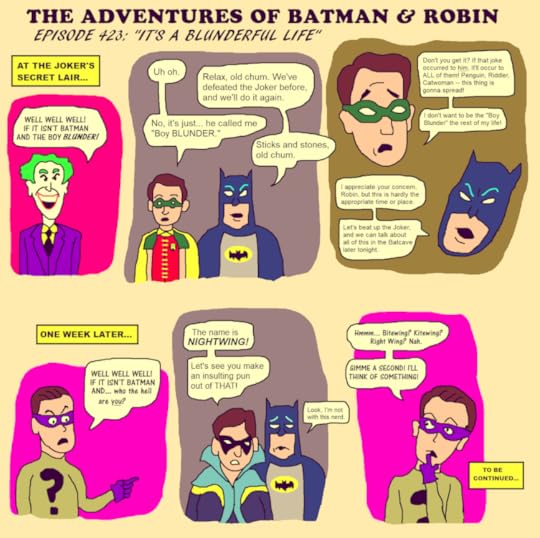 What, you think superheroes are oblivious to name-calling?
What, you think superheroes are oblivious to name-calling?For the first few years of my life (1975-1981), my family lived in a little ranch-style house in a cozy little neighborhood in Flint, Michigan, right down the street from my rambunctious Uncle John and his family. I've retained quite a few memories from those days, and some of the fondest revolve around Channel 20, a local independent UHF station we used to watch quite a lot. It showed mostly (or all?) reruns back then. Typical offerings included Lost in Space, The Adventures of Superman, The Abbott & Costello Show, and, best of all, Batman.
Thanks to MeTV, I've gotten to revisit Batman in recent years, and the series and its characters have again taken up residence in my imagination. Hence the terribly-drawn comic above. Please forgive me for it.
var infolinks_pid = 3415273; var infolinks_wsid = 0;
Published on December 04, 2024 03:00
December 3, 2024
2024 Comics Fun Advent Calendar, Day 3: The monster cereals are always in season!
 I've never had any Carmella Creeper. Is it good?
I've never had any Carmella Creeper. Is it good?I never had any of General Mills' monster cereals as a child. My parents just wouldn't go for it. Frosted Flakes and Apple Jacks were okay, but Franken Berry and Frute Brute were out of the question. I remember seeing a box of Count Chocula at a friend's house once and being consumed with both fascination and jealousy. I finally got to have them as an adult. By then, according to those who know, the recipes had been changed (for health reasons) and the cereals weren't as good as they used to be. They tasted fine to me. Maybe it's a good thing I never had any of those cereals in their '70s and '80s heyday. I might still be chasing an impossible Boo Berry high from when I was seven.
Anyway, the comic above was written back in October but I'm just sharing it now. Maybe, in this context, it's Advent and not Halloween that arouses Carmella Creeper.
var infolinks_pid = 3415273; var infolinks_wsid = 0;
Published on December 03, 2024 03:00
December 2, 2024
2024 Comics Fun Advent Calendar, Day 2: "The Next Ten Commandments"
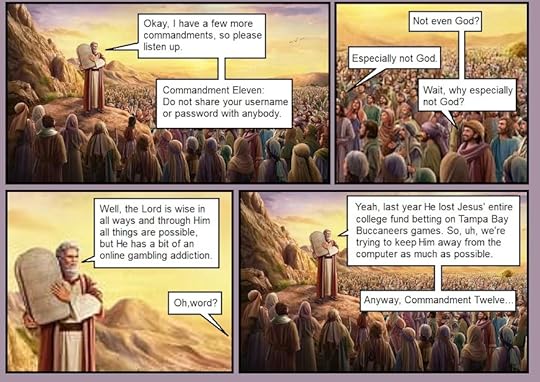 I liked the detail of the Tampa Bay Buccaneers.
I liked the detail of the Tampa Bay Buccaneers.I grew up Catholic and spent many hours of my life (through no choice of my own) at a church called St. Robert Bellarmine in Flushing, Michigan. It was a very plain, almost barn-like structure when my family started going there in the early 1980s, but the parishioners raised money and made improvements to it over the years. Eventually, it became a pretty impressive place of worship. I mean, it won't put any cathedrals to shame, but for a church in a smallish Midwestern town, it's not bad.
One of the most prominent additions to the main sacristy was a series of stained-glass windows depicting scenes from the Bible. I generally didn't have much interest in what the priest was saying, so I'd stare at those windows, one of which depicted Moses reading the Ten Commandments. I suppose that memory stayed with me and eventually inspired today's comic.
The last time I ever set foot in St. Robert Bellarmine was in August 2018 for my father's funeral. The place looked better than ever.
var infolinks_pid = 3415273; var infolinks_wsid = 0;
Published on December 02, 2024 03:00
December 1, 2024
2024 Comics Fun Advent Calendar, Day 1: Meanwhile, on the Starship Enterprise...
 Captain Kirk and Mr. Spock (both Jewish!)
Captain Kirk and Mr. Spock (both Jewish!)Two Decembers ago, I posted a series on this blog called The 2022 Ed-Vent Calendar . It was 25 continuous days of brief, bite-size articles about Ed Wood, his life, and his films. The idea was to do the blogging equivalent of an advent calendar: lots of little presents instead of one big one. I think my modest experiment yielded some fun results, and I wanted to try something similar but not exactly the same this year.
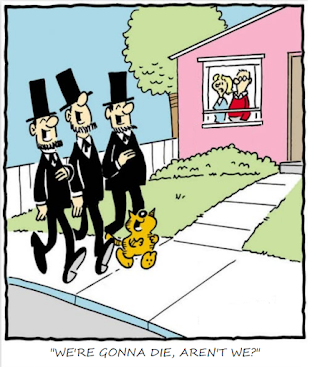 A Heathcliff parody.Many people think that this blog is only about Ed Wood, and that's admittedly a fair conclusion to draw. There is a lot of content about Eddie on this site. But it's not the only thing I do! If you go to the Dead 2 Rights main page, for instance, you'll see the logo at the top, and underneath it are several clickable labels:
Ed Wood Wednesdays
,
Happy Days
,
Comedy Classics
,
Comics Fun!
, and
Best of D2R
. Notice how Eddie is only one of those.
A Heathcliff parody.Many people think that this blog is only about Ed Wood, and that's admittedly a fair conclusion to draw. There is a lot of content about Eddie on this site. But it's not the only thing I do! If you go to the Dead 2 Rights main page, for instance, you'll see the logo at the top, and underneath it are several clickable labels:
Ed Wood Wednesdays
,
Happy Days
,
Comedy Classics
,
Comics Fun!
, and
Best of D2R
. Notice how Eddie is only one of those.This December, I wanted to shine some light on the oft-neglected Comics Fun! part of the blog. What is this? Well, I've been obsessed with comics and cartoons from early childhood, and I've been making them since I was able to hold a crayon. In junior high and high school, I used to draw silly little cartoons on notebook paper and pass them around in class, much to the annoyance of my teachers. My characters included Iffy the Troll, The Apple Scruffs, Margin Man, and an unfortunate family called The Melties who were all made from wax and yet who insisted on going outside on sunny days.
Unfortunately, I've had basically no art training apart from what I got in elementary school, and my drawing skills are minimal to nonexistent. My handwriting is a complete disgrace, and it's rare for me to draw anything with pens or pencils on actual paper these days. But I still want to make comics and cartoons. So my usual method is to patch it together from photos and artwork I've found on the internet. Occasionally, I'll take an existing comic strip and merely change the dialogue or the caption. If the artwork I want simply doesn't exist, I'll "draw" it very crudely in Microsoft Paint . (Yes, Microsoft Paint!)
After years of posting this material on the internet, I've learned that people do not enjoy my comics very much. Their typical reactions range from total indifference to mild dislike. A few years ago, I submitted some of what I considered my "best stuff" to an editor once and received a swift but polite rejection. And yet, I keep creating this material. Why? Because I find it funny. This is stuff that amuses me. These dumb, poorly-made comics and cartoons keep accumulating on my hard drive, and I can't bring myself to throw them away.
And so, until Christmas 2024 finally arrives, I will be sharing some homemade comics each day with my readers. That comic strip at the top is the first example. Basically, I saw a screenshot of a Star Trek video game that had been posted to Facebook, and I turned it into a little tragicomic saga about Kirk and Spock's working relationship. Enjoy or don't. Totally up to you.
var infolinks_pid = 3415273; var infolinks_wsid = 0;
Published on December 01, 2024 03:00
November 27, 2024
Ed Wood Wednesdays, week 204: The unveiling of Ed Wood's historical marker
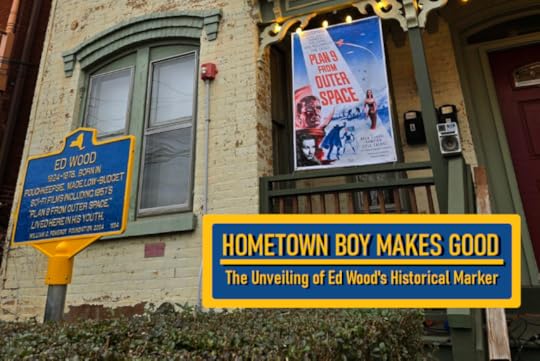 A glimpse at the unveiling of Ed Wood's historical marker.
A glimpse at the unveiling of Ed Wood's historical marker.Since Thanksgiving is approaching and most Americans are preoccupied with travel, relatives, decorating, shopping, and food—or possibly all of these—I thought I'd keep it especially light and informal this week. So no big Ed Wood revelations or in-depth Ed Wood reviews, okay? Let's just have a little Ed Wood fun.
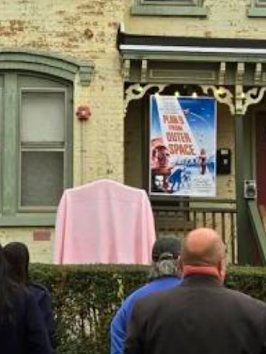 Pretty in pink?Last Wednesday, I told you about how
a New York State historical marker
was being placed in front of Ed Wood's childhood home at 35 Delano Street in Poughkeepsie, thanks to the efforts of some high school students in teacher Robert McHugh's AP history class in Dutchess County. Those enterprising youngsters cited this very blog in their application to a nonprofit organization called the
William G. Pomeroy Foundation
, which seeks to denote places of historical significance in the state of New York.
Pretty in pink?Last Wednesday, I told you about how
a New York State historical marker
was being placed in front of Ed Wood's childhood home at 35 Delano Street in Poughkeepsie, thanks to the efforts of some high school students in teacher Robert McHugh's AP history class in Dutchess County. Those enterprising youngsters cited this very blog in their application to a nonprofit organization called the
William G. Pomeroy Foundation
, which seeks to denote places of historical significance in the state of New York. And, after two years, it worked! The Foundation agreed to mark Eddie's former home with a permanent, bright blue-and-yellow sign. Anyone who walks or drives by 35 Delano Street will know that this was once the home of the director of Glen or Glenda (1953). None of this could have happened without the research of such esteemed Woodologists as Greg Dziawer and James Pontolillo, both of whom have made invaluable contributions to this blog.
I couldn't be there for the unveiling of the sign, unfortunately, but I did write a speech for the occasion. That speech was delivered for me by director and film programmer Katie Cokinos. You can view a gallery of photos from the event right here . In some of the pictures, you can see that the marker was hidden under a pink cloth before it was revealed. To my eyes, at least from a distance, the sign appears to be wearing its very own pink angora sweater! What could be more appropriate?
A 16-minute video of the unveiling ceremony has also been posted to Instagram for those who would care to watch it. It includes Katie's speech, if that's a selling point. You'll really get a sense of how charming this building on Delano Street truly is. This is some old-school construction, and it has a lot more personality than the soulless architecture we see today. I'd be proud to live in a place like this.
Before we leave this topic in the rearview mirror, I'd like to share an email I received from Katie the day after the unveiling:
Hi Joe,I only wish I could have been there in person! var infolinks_pid = 3415273; var infolinks_wsid = 0;
What an amazing event! Ed Wood’s birthplace, 35 Delano (as in Franklin Delano Roosevelt), around the corner from the Bardavon Theater, the house is owned by Roberto Rossi whose family has a deli, Rossi and Sons, a block away. Robert McHugh, history teacher at Arlington High School, organized the memorial and event along with his students. And your wonderful, inspiring, informative tribute got a rousing applause. Love that this happened during his 100th year. I felt Edward Davis Wood Jr. smiling.
Thank you for participating albeit through your writing,
Published on November 27, 2024 13:31
November 26, 2024
Podcast Tuesday: "Rome (If You Want To)"
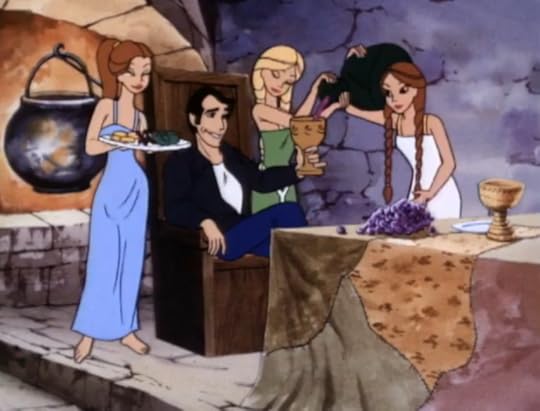 Fonzie (Henry Winkler) enjoys Rome.
Fonzie (Henry Winkler) enjoys Rome.If you were doing a time travel show and had all of history to play with, where would you send your characters? Caveman times? The far future? Ancient Egypt? The Old West? Hanna-Barbera's animated series The Fonz and the Happy Days Gang (1980-81) did all of those and more in its first season. It took until Season 2, however, before Fonzie (Henry Winkler) and his pals finally got to Ancient Rome.
This week on These Days Are Ours: A Happy Days Podcast , we're talking about that episode, "There's No Place Like Rome." It features most of what you'd expect: togas, lions, chariots, centurions, a colosseum, etc. You want men in skirts? You got 'em. Speaking of which, the show has used real historical figures occasionally, including Cleopatra, but this time they substitute a fictional character called Julius Maximus for Julius Caesar. The plot of "No Place" has Maximus trying to conquer some unnamed walled city and marry the king's daughter against her will. Naturally, his plans go up in smoke when Fonzie and friends arrive in their flying time machine.
Does this episode get a thumbs up or a thumbs down? Find out below.
var infolinks_pid = 3415273; var infolinks_wsid = 0;
Published on November 26, 2024 14:10



